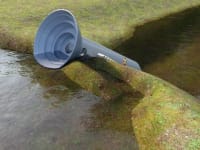Introduction
Hydropower is one of the most important renewable resources for energy. There are, however, drawbacks. Firstly, there is an ethical problem. Fish are hindered to migrate upstream and are stressed, wounded or killed migrating downstream. All over the world plans are made to mitigate this, e.g. in Europe via The Water Framework Directive https://ec.europa.eu/environment/water/water-framework/index_en.html. Building passages for fish is an important part of this scheme. Secondly, present passages (fish ways or nature like passages) require substantial free flowing water from which energy is not harvested. This means decreased production of electricity (Sweden 2%). There is an aching need for a solution to these two problems.
Objective
The project is about a combined fish way and hydro turbine. It offers a safe passage for fish in both upstream and downstream direction. During operation it generates electricity. We expect optimal size/conditions to be: flow up to 10 m³/s and head up to 10 m. We expect efficiency (mechanical) to be about 70%, and injury rate well below 1%. We calculate cost for one unit to be about the same as for a conventional hydro turbine of corresponding size.
Description
The working principle is a further development of the ancient Archimedean Screw. The new construction incorporates two spiral channels with opposite twist. Channels formed by spiral walls in the space between three cylinders. The larger of the channels (inner) determines the direction of rotation, and serves as downstream passage. The smaller (outer) of the channels forced to rotate “backwards” and so lift/pump water upstream, flow serving as upstream passage. A generator harvest the energy of the downstream net flow. A funnel shaped entrance, designed to fit fish behavior, guides fish efficiently into the downstream entrance. During rotation a ridge closes escape route behind fish on their way in.
Status
The basic two-way principle is patented in ten countries including US and Canada. The fish optimized upper entrance filed for international patent (PCT).
Initial experiments were carried out in a simple setup to test design details, acceptance by fish, and possible injuries to fish. The setup worked technically as planned, fish entered and passed through as expected, and no injures to fish were observed.
Planning
Next step is building and testing a 1:10 scale model. The plan is to verify the mechanical efficiency (percentage of available energy harvested), and to verify our finding that fish are not harmed during passage. This subproject is funded and under way.
Conclusion
The adaption of hydropower to modern environmental standards risk to be more costly than necessary when traditional fish ways (e.g., Denil bypass, slot bypass, nature like bypass) are used. If the presented new technology is implemented at a larger scale 2/3 of the otherwise lost power production can be saved. Production in countries covered by patents is about 900TWh/year.
Like this entry?
-
About the Entrant
- Name:Arne Fjalling
- Type of entry:individual
- Patent status:patented








